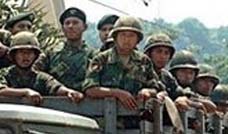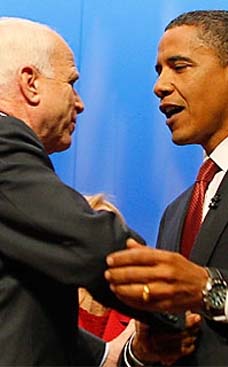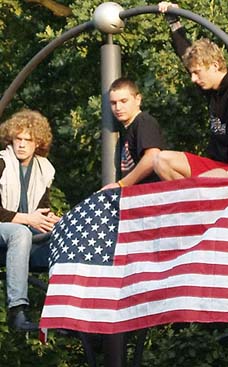
“Kennedy made that speech about doing what you could for your country, and that really caught me,” he remembers. “So I went to Washington, D.C. with my cameras. It was literally the first day of the Peace Corps, and I said, ‘Here I am, I want to be your photographer.’ But they said they needed doctors and nurses and teachers and technicians and farmers, not photographers. But I asked if I could hang around and they said yes. A couple of days later, Princess Beatrix was there and she wanted her picture taken with [Peace Corps founder] Sargent Shriver, but no one was there from the press. They looked at me and said, ‘Hey kid, you got your camera?’ I did, and I took this picture of Shriver and Her Royal Highness Princess Beatrix, and they said, ‘You’ve got the job.’ And I was with the Peace Corps for two years. They sent me around the world and my pictures were in every magazine there was. So I was an instant professional.”
Rowland Scherman spent two years as a photographer with the Peace Corps
Living in the Past
By Ed Symkus
Thu Oct 16, 2008, 04:10 PM EDT
Cambridge - It takes some guts to claim that you’re responsible for “one of the icons of the’60s.” But those are the words proudly used by photographer Rowland Scherman in describing his celebrated shot of Bob Dylan on the cover of his 1967 “Greatest Hits” album.
Scherman, who was freelancing at the time, managed to sneak backstage and snap away for a couple of minutes to get that photo, for which he was eventually paid $300 by Columbia Records and awarded a Grammy for Best Album Cover, Photography.
Oddly, the photo, of Dylan in concert surrounding by a lighting design of rich cobalt blue, his frizzy hair kind of glowin’ in the wind, was printed backward on the album cover.
Scherman, calls it the decision of the art director, and mentions that the cover shows only a small part of the whole photo.
To see what Scherman saw through is lens, check out his new show at Club Passim, where the Dylan shares wall space with 20 other shots from the ’60s and ’70s, ranging from concert portraits of the Beatles at Washington Coliseum and Crosby, Stills & Nash at Woodstock, to Bobby Kennedy on the 1968 presidential campaign trail and I.F. Stone at a small, busy publishing house.
Scherman, 70, a Cape Cod resident since 2000, remembers first shooting pictures after he landed a job in the darkroom at Life Magazine in 1957, during a summer college break.
“I had access to the darkroom to do my own stuff,” he says, “so I bought a little camera and started shooting pictures of my family. “To me, they were so stultifyingly brilliant, that I changed my major to art.”
A few years later, after a brief, unsuccessful attempt as a rock guitarist, he talked his way into a photography career, starting with a stint in the Peace Corps.
“Kennedy made that speech about doing what you could for your country, and that really caught me,” he remembers. “So I went to Washington, D.C. with my cameras. It was literally the first day of the Peace Corps, and I said, ‘Here I am, I want to be your photographer.’ But they said they needed doctors and nurses and teachers and technicians and farmers, not photographers. But I asked if I could hang around and they said yes. A couple of days later, Princess Beatrix was there and she wanted her picture taken with [Peace Corps founder] Sargent Shriver, but no one was there from the press. They looked at me and said, ‘Hey kid, you got your camera?’ I did, and I took this picture of Shriver and Her Royal Highness Princess Beatrix, and they said, ‘You’ve got the job.’ And I was with the Peace Corps for two years. They sent me around the world and my pictures were in every magazine there was. So I was an instant professional.”
Two years later, on the week that Scherman decided to go freelance, he got a call from his sister, who was assistant to the photographer that was covering the Beatles’ first visit to America.
“She said, ‘You’d better show up for these guys,’ ” he remembers her saying of their first stop in Washington. “I didn’t have a press ticket or anything. I was shooting from way back. I shot three or four rolls from back there, then I tried to get a little closer, and nobody stopped me, and then I got a little closer, and soon I had my elbows on the stage. I just sort of sneaked into it.”
Scherman admits that most of his rock work was done on the fly. Rather than getting to know his subjects, he would run in, shoot as much as he could, then get out, sometimes just before he was going to be thrown out.
Things were different when he was invited to join Bobby Kennedy on the 1968 campaign trail.
“I was sort of a family friend due to the Peace Corps,” he says. “So I had pretty good access on that campaign. I was crawling all over the place, and nobody stopped me.”
Of his rock photos, which make up most of the Passim show, he says, “In those days they wanted you to take their picture. Nowadays, they’d take you and your camera and throw you out.”
But at the end of the 1960s, Scherman lost interest in photography. He was a bartender for a while. He moved to Wales and became a sheepherder. He was on what he now refers to as “a 40-year hiatus” from photography, although he did turn out some beautiful landscape work from time to time.
But shortly after he moved to the Cape, he met photo printmaker Bob Korn and conservation framers Dave and Meri Hartford, with whom he got to talking about his days of rock and political photography.
“The magic of the past couple of years was that Bob and the Hartfords have helped me by cataloguing what would have been for one person an impossible job. They’ve gotten me on the ball and organized my stuff in a way that it hasn’t been organized since 1968. They really kind of stitched my life back together.”
Most of his photos and negatives had been stored away in manila folders and glassine envelopes, and Life Magazine had a lot of his work. Scherman just hadn’t given a lot of thought to his past days.
“Sometimes it takes a separate set of eyes to see the shine of stuff,” he says of Korn’s insistence that they get his work back on display.
And Scherman is now back behind the lens, shooting family portraits and Cape scapes.
Asked if he misses the ’60s, he candidly says, “Yeah, sexually I do. Everyone was on the pill and AIDS hadn’t been discovered. I miss that part of it. But there were also all the tragedies. It’s an unsung melody what the world would have been like if JFK and Martin Luther King and Bobby Kennedy had lived. We seemed to have everything going for us, but it ended with those assassinations. The big turning point was Vietnam.
“By the way,” he adds, “Life asked me if I wanted to go to Vietnam, and I said. ‘No, thanks.’”
“Legends: The Works of Rowland Scherman” is at Club Passim, 47 Palmer St., Cam. through Nov.15. There’s no admission charge during non-concert hours. Call 617-492-5300.
Ed Symkus can be reached at esymkus@cnc.com.













